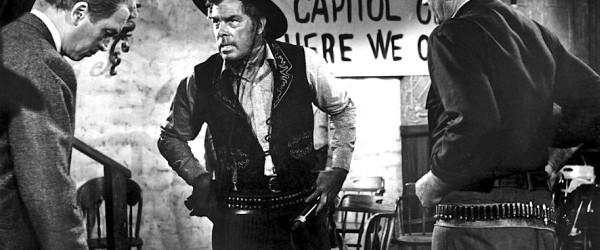
Dir: John Ford | Writer: James Warner Bellah | Cast: James Stewart, John Wayne, Vera Miles, Lee Marvin, Edmond O’Brian, Andy Devine | 123min | US | Western
“Senator Ransom Stoddard returns to Shinbone for the funeral of a pauper and tells an enquiry reporter the true story of the man who shot Liberty Valance.”
That is Peter Bogdanovitch’s summary of The Man Who Shot Liberty Valance, to be found in his interview book with John Ford. This is not the movie pitch that Ford gave to his producer Willis Goldbeck at Paramount, but its Fordian straight talking will do, or maybe won’t do, for it disguises the complex inner movement, contradiction and irony of this thoughtful late masterwork. Peckinpah’s Ride the High Country (1961) and Siegel’s The Shootist (1976) both exude the same penetrating melancholy found in classic Westerns yet neither have the same philosophical reflection on American history and politics. For The Man Who Shot Liberty Valance asks the question, “What really civilised the Wild West – the law book or the gun?” The answer could well be ‘both’. For if violence was a prerequisite for conspicuous heroes back then (or maybe still now?) dutiful lawmaking quickly accompanied it.
As the real Valance story opens in flashback, Liberty Valance (Lee Marvin) and his gang hold up a stagecoach and rob the passengers. Newly qualified lawyer Ransom Stoddard (James Stewart) is savagely beaten up and his law books are damaged. Apart from Valance’s sadistic glee (relished by Lee Marvin) the reasons for his violence are never quite made obvious. Valance is a ‘bad man’ who yields a silver whip that he frequently unleashes on bar room tables. Although Ford and his scriptwriters don’t create a stereotyped baddie, Valance is not subtly drawn. At another level, he exists as a symbolic force – a miscreant unable to accept civilising change. Not helped by a cowardly marshal Link Appleyard (Andy Devine) who is running away from arresting Valance. A clue to his power lies in his name. Liberty = freedom, whilst Valance suggests health and strength. It’s going to be difficult for Stoddard and rancher Tom Doniphon (John Wayne) to put down the larger than life monster Valance, who is a pale reflection and distortion of the violence in their own democratic natures.
Lee Marvin does ham up his role, conveying an untrammelled egoism, but shrewdly disciplines his part. Andy Devine’s conversion from a foolish marshal to wiser old man never quite convinces. And Edmond O’Brien’s performance as Shinbone’s newspaper editor is a strong case of over-acting, but gloriously entertaining. To balance up the moral focus, we have John Wayne, James Stewart and Vera Miles, all at their brilliantly serious best as the winners and losers from Valance’s death.
The Man who Shot Liberty Valance is filmed im black and white (and the muted grey tones bring out its sadness.) Apart from the visual economy of the street gunfight, Valance is not one of Ford’s most beautiful looking films. For this is an intimate chamber piece. The film is driven by much dialogue as it explores its characters and their fate in a story of disenchantment, regret and lost aspirations.
Critics and teachers have written on this film, which along with the original story written by Dorothy M. Johnson, has now become an aid for teaching American history. Indeed one of the best moments in Valance is the classroom scene where James Stewart attempts to instruct the barely literate residents of Shinbone in Politics. Yet history lessons to one side, the film’s most quoted line is “This is the West, sir. When the legend becomes fact, print the legend.” In our new age of so-called ‘Trumpism” you can take this to mean fake news, or simply the fact that the film Western has consistently exalted romance and archetypes of good and evil (Though Altman’s McCabe and Mrs. Miller from 1971 and Penn’s The Missouri Breaks from 1976 go elsewhere in disparaging and breaking with those requirements).
The Man Who Shot Liberty Valance is a questioning and tragic work: yet its vision is too organic and conservative to upturn Western conventions. A death in the community and its political and personal consequences concern it more.
“Nothing’s too good for the man who shot Liberty Valance.” says the railwayman to Stoddard on leaving Shinbone. And really nothing’s too good for John Ford the great poet who so deeply shaped our view of the American West. Deservedly cited as one of the best westerns ever made, now the Blu – Ray edition allows you to fully experience its elegiac power. Alan Price.
NOW AVAILABLE ON BLURAY